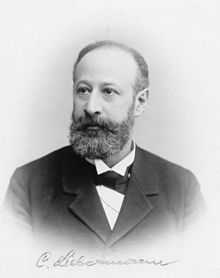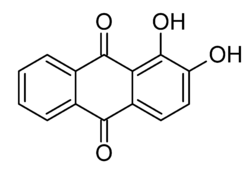Carl Theodore Liebermann
| Carl Theodore Liebermann | |
|---|---|
 Carl Theodore Liebermann | |
| Born |
23 February 1842 Berlin, Germany |
| Died |
28 December 1914 (aged 72) Berlin, Germany |
| Institutions | University of Berlin |
| Alma mater | University of Berlin |
| Doctoral advisor |
Robert Wilhelm Bunsen, Adolf von Baeyer |
| Known for | Synthesis of Alizarin |
Carl Theodore Liebermann (23 February 1842 – 28 December 1914) was a German chemist and student of Adolf von Baeyer.
Life
Liebermann first studied at the University of Heidelberg where Robert Wilhelm Bunsen was teaching. He then joined the group of Adolf von Baeyer at the University of Berlin where he received his Ph.D. in 1865.
Together with Carl Graebe, Liebermann synthesized the orange-red dye alizarin in 1868. After his habilitation in 1870 he became professor at the University of Berlin after Adolf von Baeyer left for the University of Strasbourg. Shortly after Liebermann retired, in 1914, he died.[1][2]
Work

In 1826, the French chemist Pierre Jean Robiquet had isolated from the root of a plant, madder, and defined the structure of, alizarin, a remarkable red dye. Liebermann's 1868 discovery that alizarin can be reduced to form anthracene, which is an abundant component in coal tar, opened the road for synthetic alizarin.[3][4] The patent of Liebermann and Carl Graebe for the synthesis of alizarin from anthracene was filed one day before the patent of William Henry Perkin. The synthesis is a chlorination or bromination of anthracene with a subsequent oxidation forming the alizarin.[5]
References
- ↑ P. Jocobson (1918). "Nekrolog: Carl Liebermann". Berichte der deutschen chemischen Gesellschaft 51 (2): 1135–1204. doi:10.1002/cber.19180510202.
- ↑ Giesel, F. (1915). "Carl Liebermann †". Zeitschrift für Angewandte Chemie 28 (8–9): 25. doi:10.1002/ange.19150280802.
- ↑ C. Gräbe, C. Liebermann (1868). "Ueber Alizarin und Anthracen". Berichte der deutschen chemischen Gesellschaft 1 (1): 41–56. doi:10.1002/cber.18680010142.
- ↑ C. Gräbe, C. Liebermann (1868). "Ueber Farbstoffe aus der Anthracengruppe". Berichte der deutschen chemischen Gesellschaft 1 (1): 104–106. doi:10.1002/cber.18680010142.
- ↑ C. Graebe, C. Liebermann (1869). "Ueber künstliche Bildung von Alizarin". Berichte der deutschen chemischen Gesellschaft 2 (1): 14–14. doi:10.1002/cber.18690020106.
Associated articles
|